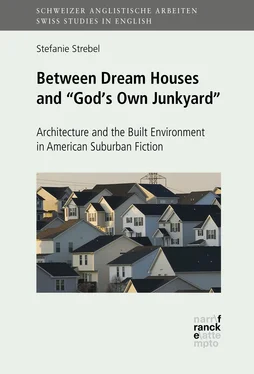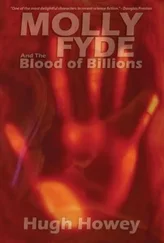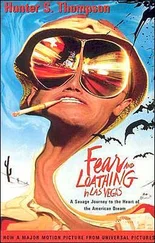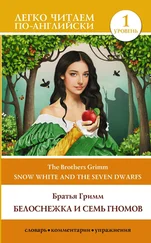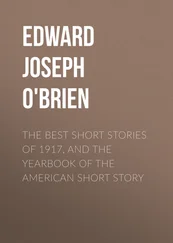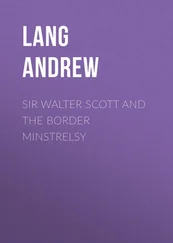The focal points of the Suburban Gothic are anxieties associated with the suburb – anxieties which began to emerge with the rapid artificial creation of suburban communities from the mid-1940s onward. Among the most important literary representatives of the genre are Shirley Jackson’s The Haunting of Hill House (1959), Ira Levin’s The Stepford Wives (1972) and Anne Rivers Siddons’ The House Next Door (1978), but also more recent publications such as Bret Easton Ellis’ Lunar Park (2005) belong to the Suburban Gothic. As far as film is concerned, it is arguably Tobe Hooper’s Poltergeist (1982) and Tim Burton’s Edward Scissorhands (1990) that stand out the most, and the same holds true for David Lynch’s Twin Peaks (1990-1991) in television. The already mentioned drama series Desperate Housewives certainly has Gothic undertones relating to the secret world that evolves behind immaculate architectural façades, too. As Murphy observes in her book on The Suburban Gothic in American Popular Culture , “[i]n the Suburban Gothic, one is almost always in more danger from the people in the house next door, or one’s own family, than from external threats” ( Suburban Gothic 2), and this is doubtlessly a central underlying premise of this highly popular series.
Although there has been an emphasis on the importance of the suburb in the United States and a focus on American texts and culture heretofore, it must be emphasised that the suburb is by no means an American invention, and that wherever in the world there are cities with adjacent flat or, as seen in many South American favelas, also mountainous land, there is bound to be a suburban sphere corresponding to the various definitions of the concept. Possibly due to the similarities of culture brought about by a shared origin and common language, most parts of the world permanently colonised by the British have suburban patterns that are comparable to those in the United States to a large extent, even though they often have a less pronounced presence in the social discourse, in popular culture and thus also in literature.4
While it is undeniable that the cultural output on suburbia is the most visible and perceptible in the United States, there are certainly works in other literatures of the Anglosphere that prominently feature the suburb as a core concept. In the United Kingdom, for instance, novels such as Leslie Thomas’ Tropic of Ruislip (1974), Julian Barnes’ Metroland (1980), Hanif Kureishi’s The Buddha of Suburbia (1990), as well as J. G. Ballard’s Kingdom Come (2006) are part of the literary suburban discourse. All these novels are set in the London metropolitan area, where the modern suburban history of England and the world began. Tropic of Ruislip and Metroland are both set in the Northwest London “Metroland” promoted by the Metropolitan Railway in the early twentieth century, whereas the story of The Buddha of Suburbia begins in the suburbs of South London. Only a few decades earlier, until well into the 1930s, the Metroland was still advertised as an Arcadian idyll, and it is therefore interesting to observe how attitudes towards this specific landscape had changed by the 1970s and 1980s. South London, in contrast, never enjoyed the same historical reputation as its north-western counterpart, and the humorous and somewhat sentimental attitude of boredom displayed towards this part of the city in Kureishi’s novel is therefore not a testimony to a change in public perception. The same holds true for Kingdom Come , Ballard’s last novel, which is set in a fictional suburb called Brooklands between Weybridge and Woking, and is thus also located outside the once-glorified Metroland.
Even though there are certainly more examples than the ones mentioned here, it cannot be denied that in comparison to the literary and cinematic output in the United States, suburbia is a concept that receives less emphasis in Anglo-European literature, and the same applies to other English-speaking countries such as Canada, Australia and New Zealand. As Nathanael O’Reilly (xi) points out in his book on the suburb in the contemporary Australian novel, for instance, “[d]espite the fact that the vast majority of Australians live in suburbia, Australian narratives are rarely suburban.” The widespread representation of this environment in literature and popular culture is therefore a phenomenon that is attributed predominantly to the United States, and suburbia as such must be considered a far greater socially and environmentally determining force in this country.
Despite the emphasis on literature, film and television here, when it comes to popular culture in both the United States and other English-speaking countries, it must be pointed out that the impact of suburbia is by no means limited to these cultural domains. The suburban experience has also been expressed in music, most notably in the iconic song “Little Boxes” by Malvina Reynolds, composed in 1962 as a satire targeted at the mass development of suburbs and their middle-class conformity. “Little Boxes” was also used as the theme song for Weeds , which popularised the piece among a new audience more than forty years after its first release:
Little boxes on the hillside, little boxes made of ticky-tacky,
little boxes on the hillside, little boxes all the same.5
There’s a pink one and a green one, and a blue one and a yellow one,
and they’re all made out of ticky-tacky, and they all look just the same.
(Malvina Reynolds)
Another important cultural statement is the song “Suburbia” (1986) by the Pet Shop Boys, which was inspired by the violence and social tensions in the already mentioned eponymous 1984 film by Penelope Spheeris – “Let’s take a ride / and run with the dogs tonight / in suburbia” (Pet Shop Boys) –, as well as by the Brixton riots. Furthermore, a more recent example in music is the 2010 album The Suburbs by Arcade Fire, in which the band musically portray the processes and conflicts of growing up in the urban periphery with songs such as “City with No Children,” “Suburban War” or “Sprawl I (Flatland)” and “Sprawl II (Mountains Beyond Mountains).” The album went on to serve as an inspiration for Spike Jonze’s half-hour dystopian short film Scenes from the Suburbs (2011), which was a tight collaboration between Jonze and the band. Apart from music, the suburbs have also found their way into the arts of painting and photography, in which one of the most prominent suburban tropes was born: the aerial shot of rows upon rows of uniform tract housing stretching into infinity. Arguably the most comprehensive overview of the cultural representation of this landscape can be found in Rupa Huq’s outstanding 2013 book Making Sense of Suburbia Through Popular Culture , in which every genre of popular culture from literature to rap music is covered.
The Architectural Suburb and Its Literary Representation
When it comes to architectural concerns, the deep embeddedness of the suburbs in popular culture also becomes apparent in the fact that contemporary social and planning-related developments in this environment are an ever-recurring topic in popular online magazines such as The Atlantic or CityLab . From an architectural point of view, it is exactly this close-knit tie with popular culture that makes the suburbs less interesting for this field of study, since architecture considers itself to be a high art that strives for aesthetic appeal. The symbolic elevation of the architect over other building professions is already present in the etymology of the term (Greek: “ἀρχιτέκτων,” meaning chief builder, or Old English: “heahcræftiga,” meaning high-crafter), and finds its repercussion in the buildings designed or constructed. As architectural critic Nikolaus Pevsner once famously claimed, “[a] bicycle shed is a building; Lincoln Cathedral is a piece of architecture. Nearly everything that encloses space on a scale sufficient for a human being to move in is a building; the term architecture applies only to buildings designed with a view to aesthetic appeal” (Pevsner 21).
Читать дальше
